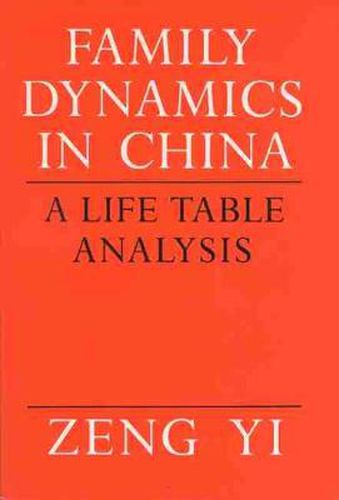Family Dynamics in China: A Life Table Analysis
Zeng Yi

Family Dynamics in China: A Life Table Analysis
Zeng Yi
This text establishes three major milestones in demography. It provides the first English-language demographic profile by a Chinese author of contemporary population trends and family dynamics in China: it constructs a viable mathematical model for extending existing family-status life table models to the three-generational family that is still common in China and the rest of Asia: and it uses that model to compare the dynamics of family structure in China before and after the dramatic drop in fertility that followed the 1979 implementation of stringent family size limits. 20 percent of the world’s population lives in the People’s Republic of China, yet relatively little has been known about its population structure. The 1982 census of population, the first in China to use sophisticated techniques of data collection and analysis, made it possible to examine family characteristics and their determinants: marriage, widowhood, and divorce: fertility and mortality: and rural-urban, ethic, and regional differences.
Family Dynamics in China
draws on both the 1982 census and other demographic data collected during the 1980’s. This general analysis provides the framework for a mathematical model that uses its starting point family-status life table models, developed by Bongaarts and others, that simultaneously include multiple variables such as age, marital status, parity, and fecundity. These models have been based upon the nuclear family and have assumed tht adult children necessarily leave theri parents’ homes at marriage. Yet the 1982 Chinese census indicated that nearly 20 percent of all Chinese families contained three or more generations. By extending existing models to accommodate the multigenerational family. Yeng Yi has made an important methodological advance that is applicable to many other non-Western societies. In the last part of
Family Dynamics in China , this new model is systematically applied to analyzing the dramatic decline in fertility in China since 1979. Yeng Yi compares conditions from 1950 to 1970 with those now unfolding. What are the effects of the decline in fertility upon family size and structure, and upon the family life course of women, in particular?. How many years will be spent caring for children, how many for the elderly parents: what is the overlap-the
period of overload
when families may be caring for both?. As family size diminishes, for example, the proportion of elderly, particularly women, who have no surviving children is risking, especially in the cities. What are the likely social consequences of this in a society where the multigenerational family remains the primary social support system for the elderly?.
This item is not currently in-stock. It can be ordered online and is expected to ship in approx 2 weeks
Our stock data is updated periodically, and availability may change throughout the day for in-demand items. Please call the relevant shop for the most current stock information. Prices are subject to change without notice.
Sign in or become a Readings Member to add this title to a wishlist.


